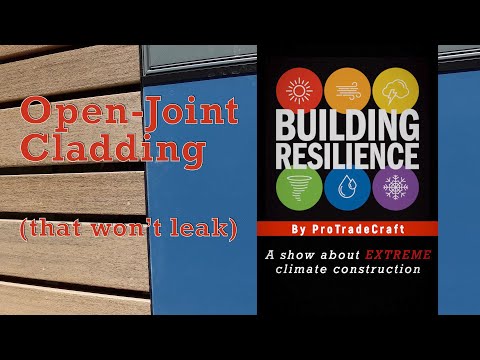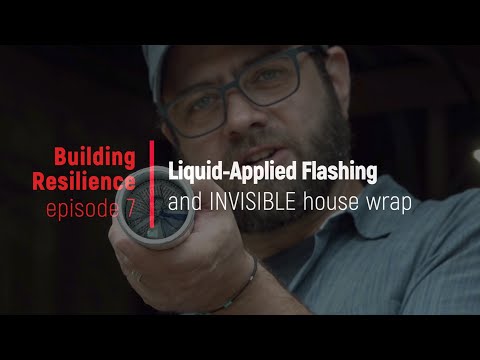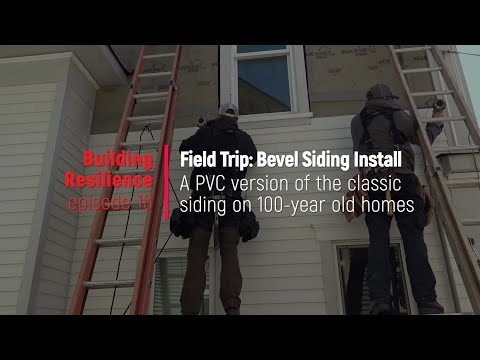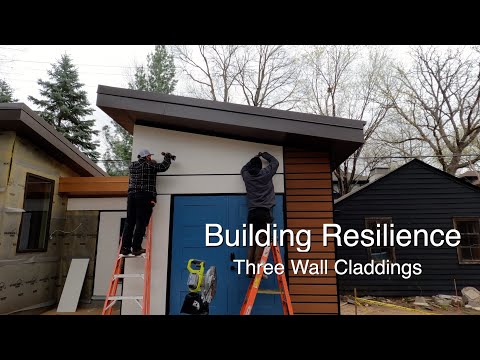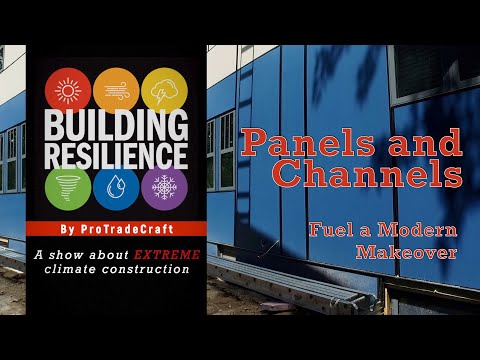Open cladding lets rain flow through, so a watertight—and UV Resistant— WRB is critical
Aw geez, look at this. You buy ‘em donuts, and what do they do? They go looking for coffee!
Welcome back to Building Resilience.
Maybe you remember, last time we were installing AZEK sheets with PaintPro technology into the ground and onto the house. The sheets were the “board” part of the board-and-batten siding installation.
We were also gluing joints on long pieces of trim and screwing the pieces home.
This time, we’re going to open up the show by talking about cladding.
Two cladding types on this house
"All right, let’s talk about cladding. So we are using two primary types of cladding. PVC panels and PVC decking that’s wrapped in vinyl.
The PVC panels are actually two different kinds of panels. The panel below me is a half-inch thick PVC panel from AZEK; it’s called their PaintPro panel because it’s super easy to paint. And on top of that, we’re going to put a three-quarter-inch thick PVC batten. Above me, we’re going to put a three-quarter-inch thick panel. And that is more of a panel and channel, a more contemporary look where the board and batten are a little bit more traditional.
For our open joint, we’re using the AZEK cladding. Which is a PVC. It’s 100% PVC decking that has a vinyl wrap.
And so, around all of our connections, we have these trim details. So we can run all of our material about 1/16 tight, and then after it goes through its first season, it will contract another 1/16 of an inch for about a ⅛ of an inch gap. Which isn’t much, but we still don’t necessarily want to see any of those gaps, so we use these really cool trims which give it both a more modern look but also hide any of our cuts, you know.
We’re perfect in our cuts, but sometimes we’re not.
And any expansion and contraction that may take place with any of these materials."
Open joint cladding is not a bulk water barrier like most siding types
Open joint cladding is basically decking on a wall with large gaps between the deck boards. The system on this house has battens to hold the deck boards off the wall and metal trims from Tamlyn to clean up the edges and transitions.
Once the battens are up, they install the trims—at window edges, corners, and other vertical breaks.
Next, Sol chucks some pieces to Stephen, who slides them into the channels, gaps off the bottom, and screwed into the battens.
The guys use spacer blocks between decking pieces and fasten each board with two screws per end. The screw holes are plugged with matching material for an invisible look.
Basically, once you know that stuff, you just keep doing that for the rest of the day.
I guess there is one more hitch, the architects designed a pattern for the decking widths.
Skinny, wide, skinny, skinny, wide, skinny, wide, skinny, skinny, wide…
On the bigger wall, the guys try stacking all of the pieces and then gapping them as they go along. I guess because they get tired of climbing up and down the ladder.
The secret to panel and channel cladding is architectural trim channels
"If you haven’t worked with panel and channel, it’s a different process. And the way that we make it look good is the use of metal trims, and we’re using Tamlyn’s extreme trim, a black anodized trim.
But when I say the word "trim," I’m really referring to these little pieces of metal that are all around me here. And they’re how we stop and start—all of our terminations and connections are going to be done with these metal trims.
So where our board and batten end, we’ve got this projection right here that’s going to cover the cut end of our batten and our board. Where this belly band meets the corner, you can see it’s got this little wing that sticks out, and that means that if this edge contracts a little bit because PVC does shrink a little bit, you’re not going to be able to see it. It’ll also hide any imperfections in our carpentry.
Of course, we have no imperfections, but in the case that we did, that would hide that.
Around the window, the same thing. I have another trim here, it just looks like an extension of the window, and it hides that cut edge of the PVC deck. Because, of course, the beautiful part of this is on the outside, and once you cut it, you wouldn't want to look at the side of that board.
So the use of metal trims is really, really important, and it creates a very sharp look for the house."
At the top of the window, another Tamlyn trim piece is installed to cap the open cladding and capture the bottom of the AZEK PaintPro sheets that will finish off the wall.
Bulk water management is the most important job of siding and wall cladding
You can see one of those sheets here, but the real reason for this photo is the kickout flashing.
Kickout flashing replaces the lower-most piece of step flashing and is bent to direct water away from the wall below the roof.
It is simple to bend and even simpler to buy.
You can tell if you are on a high-quality jobsite if you see kickout flashing installed at roof-to-wall transitions.
And you can tell if your rainscreen is working by committing a weird science infraction. The point of rainscreen siding is to allow water to escape SHOULD it ever get behind it.
So Michael’s gonna pour a bunch of water behind it to see if it can escape and how quickly.
Well, that seems to work. Pretty much as soon as he pours the water in, it escapes out the bottom.
Rainscreen upheld.
You can recycle AZEK PVC cladding and trim
Now, let’s get back to the show…
"We like working with PVC. It’s lightweight; we can use all of our normal woodworking tools, our routers, our saws, heck, you can even whittle the stuff. Remember, kids, always away from you, never towards yourself.
But the really cool thing about it is that it’s recyclable. I guess that’s cool but what’s even cooler is that it does get recycled. So all of this PVC scrap goes in these bins that AZEK provides for us, which means that the product that they make goes back to the manufacturer; it gets recycled and sent back out to the field as new PVC.
So it’s a cradle-to-cradle product; it never sees the graveyard. So we don’t have to feel bad about using PVC and generating waste because it’s just going to go back into making brand new products, and that’s awesome."
Another thing that’s awesome—is a field trip!
"We're at the international headquarters of OA Design, Build, and Architecture, this beautiful building built in 1904..."
And we’re gonna install some of AZEK’s new bevel siding over a layer of SlickerMax with some fancy spacer blocks.
Because everyone likes a field trip. Especially one on Building RESILIENCE.
—Building Resilience is a production of the SGC Horizon media network. See all of season two here.

